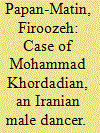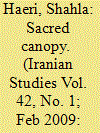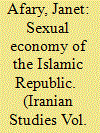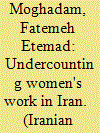|
|
|
Sort Order |
|
|
|
Items / Page
|
|
|
|
|
|
|
| Srl | Item |
| 1 |
ID:
087179


|
|
|
|
|
| Publication |
2009.
|
| Summary/Abstract |
In his speech at Columbia University, President Mahmud Ahmadinejad stated that there are no homosexuals in Iran. His attempt was to avoid the subject and any ensuing controversies that could hamper the nuclear talks at the United Nations General Assembly the following day. The present study will argue that the denial of homosexuality has been selectively applied to situations when the most prudent alternative was to overlook the issue or to keep quiet about it. A few years earlier, while the former president, Mohammad Khatami, was still in office, this attitude determined the course of action in dealing with Mohammad Khordadian, a famous Los Angeles based Iranian-American male cabaret dancer who was also rumored to be gay. In the spring of 2002, Khordadian visited Iran for the first time in more than twenty years. The authorities considered it an offense that he dared to challenge the morality codes of the Islamic Republic by crossing the border into Iran without any apprehension. The imprisonment and trial of Khordadian is a unique case in focus.
|
|
|
|
|
|
|
|
|
|
|
|
|
|
|
|
| 2 |
ID:
087177


|
|
|
|
|
| Publication |
2009.
|
| Summary/Abstract |
The curtailment of women's rights in the Islamic Republic of Iran has received a great deal of scholarly attention. Among the legal changes that have profoundly affected women's lives are divorce laws. If the legal arena has not given women much room for maneuver, the realm of cultural representation, particularly cinematic production by women, has provided a fertile ground for self-expression and resistance. Through an analysis of Ziba Mir-Hosseini and Kim Longinotto's ethnographic documentary, Divorce Iranian Style (1998), and two feature films, Blackboards (2000) by Samira Makhmalbaf and Ceasefire by Tahmineh Milani (2006), this article explores representations of the ways in which women work within and against the grain of the dominant structures of power.
|
|
|
|
|
|
|
|
|
|
|
|
|
|
|
|
| 3 |
ID:
087175


|
|
|
|
|
| Publication |
2009.
|
| Summary/Abstract |
Anthropological participant observation during two different periods (1978-79 and 2003-08) documents dramatic change in gender identity and expectations in an Iranian village. While patriarchal definitions of females and their places and on-the-ground social conditions restricted female agency and kept women and girls under the authority of male supervisors 30 years ago, recent years have witnessed growing opportunities for females. Now most girls complete high school before marriage, and may even travel to other cities for higher education. In "Aliabad," however, for the great majority, more education for females has not led to participation in the labor market. Ethnographic research focuses on how young females negotiate between the more traditional expectations and cultural constraints and the new opportunities to serve their own interests as best as possible. Although work outside of the home presents too many difficulties for the great majority of Aliabad females, who must marry in order to obtain financial support, females have used their education and the increased self-confidence, experience, status, and literacy to develop more influential positions within the marriage relationship, among kin and in-laws, and in the community. Young village women have been involved in constructing their evolving identities in an environment of social change and modernization.
|
|
|
|
|
|
|
|
|
|
|
|
|
|
|
|
| 4 |
ID:
087174


|
|
|
|
|
| Publication |
2009.
|
| Summary/Abstract |
Trends in intra-family relationships in Iran point to fast changes in regional and class-linked cultural patterns following the rapid spread of the national culture and of modernist ideologies and practices. People redefine their responsibilities and expectations as small nuclear families increase, women aspire to higher education and employment, and the bad economic situation necessitates various adaptations. Analysis of recent ethnographic data suggests that the shift from traditional authoritarian intra-family relations to relationships based on autonomy, individuation, independence and companionship creates new intimacies but also conflicts. The prevailing ideology of "progress" in Iran likely will further weaken patrilineal ties and kin relations while strengthening ties based on friendship and collegiality.
|
|
|
|
|
|
|
|
|
|
|
|
|
|
|
|
| 5 |
ID:
087178


|
|
|
|
|
| Publication |
2009.
|
| Summary/Abstract |
In this article I describe what I see as the subliminal messages of desire and intimacy in the following Iranian movies: Gabbeh (1995), The Blue Scarf (1994), May Lady (1997), and Born in the Month of Mihr (2000). I argue that although the Islamic legal discourse has reasserted itself after the revolution of 1979 and appears to have become dominant, the "erotic" discourse that is ever so subtly embedded in Persian poetry and popular culture is alive and possibly thriving. Taking a light-hearted approach, I discuss representations of love and sex in these four films within the context of the dynamic tension between the legal discourse that regulates the gaze, ahkam-i nigah, and the erotic discourse that subverts the very same regulations, nazar-bazi
|
|
|
|
|
|
|
|
|
|
|
|
|
|
|
|
| 6 |
ID:
087173


|
|
|
|
|
| Publication |
2009.
|
| Summary/Abstract |
This article examines the gender and sexual policies of the Islamic Republic and their ramifications. It argues that the policies of the Islamist government cannot easily be categorized as "puritanical" or "moralistic." Rather we can argue that various factions within the state actively deployed a new "sexual economy" for the population. Sometimes, the Islamist state privileged patriarchal interpretations of gender norms over more modern ones. At other times, it adopted modern projects such as family planning alongside a discourse that presented them as practices rooted in traditional Islam. In all cases, the state used modern institutions to disseminate and enforce these practices.
|
|
|
|
|
|
|
|
|
|
|
|
|
|
|
|
| 7 |
ID:
087176


|
|
|
|
|
| Publication |
2009.
|
| Summary/Abstract |
This paper explores the possibility of a considerable undercounting of women's labor force participation in the official surveys in Iran. According to the official data, the proportion of females in the total active labor force was about 15.5 percent in 2006. Furthermore, according to the official data the share of female in total active labor in agriculture was about 10 percent in 1996. An examination of a large body of field research on the subject, however, suggests a much higher participation rate, about 40 percent of total agricultural labor. This paper will examine these studies and explore the reasons behind the underestimations. Pointing at the growing visibility of urban women in public space, the increasing share of skilled and educated women, rising cost of living, and the need for both male and female incomes to support an urban family, some observers have suggested that the official data underestimate urban female labor participation, as well. Informal urban labor, however, has not been adequately studied. Anecdotal information, however, suggests the existence of a significant female informal economy in both traditional and modern industries. In 2001, I undertook a micro study of 350 working age women in the affluent northern part of Tehran and found that a large number of educated upper and middle class women were active in the informal market. This finding was in sharp contrast to the studies in other developing countries in which informal participants are generally poor and unskilled and are unable to join the modern formal economy. This paper will also explore the reasons for undercounting of urban female labor.
|
|
|
|
|
|
|
|
|
|
|
|
|
|
|
|
|
|
|
|
|